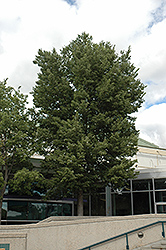>> Home
Delta Hackberry
Celtis occidentalis 'Delta'
Height: 45 feet
Spread: 40 feet
Sunlight:
![]()
Hardiness Zone: 2b
Description:
A very hardy strain of this tough and rugged shade tree selected from a stand in central Manitoba; interesting warty bark, looks quite beautiful with age; an incredibly adaptable tree for the most difficult of sites
Ornamental Features
Delta Hackberry has rich green deciduous foliage on a tree with a round habit of growth. The pointy leaves turn buttery yellow in fall. The warty gray bark adds an interesting dimension to the landscape.
Landscape Attributes
Delta Hackberry is a deciduous tree with a more or less rounded form. Its relatively coarse texture can be used to stand it apart from other landscape plants with finer foliage.
This tree will require occasional maintenance and upkeep, and is best pruned in late winter once the threat of extreme cold has passed. It is a good choice for attracting birds to your yard. Gardeners should be aware of the following characteristic(s) that may warrant special consideration;
- Insects
Delta Hackberry is recommended for the following landscape applications;
- Shade
Planting & Growing
Delta Hackberry will grow to be about 45 feet tall at maturity, with a spread of 40 feet. It has a high canopy with a typical clearance of 7 feet from the ground, and should not be planted underneath power lines. As it matures, the lower branches of this tree can be strategically removed to create a high enough canopy to support unobstructed human traffic underneath. It grows at a slow rate, and under ideal conditions can be expected to live for 80 years or more.
This tree should only be grown in full sunlight. It is an amazingly adaptable plant, tolerating both dry conditions and even some standing water. It is considered to be drought-tolerant, and thus makes an ideal choice for xeriscaping or the moisture-conserving landscape. It is not particular as to soil type or pH, and is able to handle environmental salt. It is highly tolerant of urban pollution and will even thrive in inner city environments. This is a selection of a native North American species.

